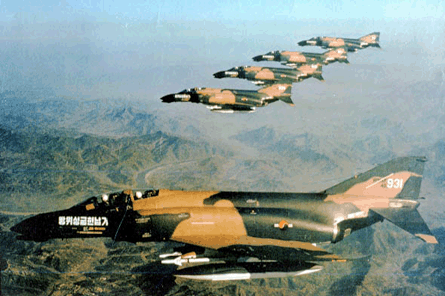South Korea faces a threat to its existence - in the shape of its neighbour, North Korea.
Though its air force is obsolete, Pyongyang would enter a conflict with the ability to inflict immense damage in a short time.
It has made little secret of its efforts to develop nuclear weapons and the missiles to carry them, and it has over 1,000 artillery pieces within firing range of South Korea's capital, Seoul - with many in hardened bunkers.
There is also China to consider, which has long served as North Korea's superpower backer.
In a war, neutralizing these manifold threats would fall mainly on the shoulders of the Republic of Korea Air Force (ROKAF), though it could rely on help from the US.
 |
|---|
© BoeingThe ROKAF needs to replace more than 60 McDonnell Douglas F-4 Phantoms |
Though the ROKAF has a strong force of Boeing F-15K and Lockheed Martin KF-16 fighters, it needs to replace more than 60 McDonnell Douglas F-4 Phantoms.
In late July, Seoul's Defence Acquisition Program Administration (DAPA) shortlisted four possible replacements to meet its FX-III upgrade programme requirements: Boeing's F-15 Silent Eagle, Lockheed Martin's F-35 Lightning II, the Eurofighter Typhoon and Sukhoi's developmental PAK-FA.
Boeing and Lockheed Martin have said that they both expect a formal request for proposal (RFP) for 60 aircraft in early 2012, with deliveries to start in 2016.
"Korea is still looking at its requirements, funding profile and potential acquisition strategy," said one executive involved in the campaign.
Boeing enters FX-III in a strong position. Its twin-seat F-15K, a variant of the F-15E Strike Eagle, emerged victorious in both FX-I, for 40 aircraft and FX-II, for 21 aircraft.
Deliveries of the second batch are likely to be completed in the second quarter of 2012.
Though final assembly of the F-15K takes place in St Louis, the aircraft's wings, forward fuselage, wire harnesses and heads-up-displays are produced in South Korea.
"The F-15SE offers Korea the flexibility to field an aircraft with both reduced radar cross-section capability and a heavy combat payload," said Howard Berry, Boeing's FX-III campaign manager. "We do this by offering the conformal weapons bay (CWB) for selected mission profiles, and the ability to convert into a heavier configuration for a variety of missions."
Eying FX-III, Boeing announced in November 2010 that Korean Aerospace Industries (KAI) would design, develop and manufacture the Silent Eagle's CWB.
Berry said the CWB can be removed within three hours.
"We are the only competitor optimised for maximum capability for different mission requirements, as opposed to being specifically tailored to one type of mission, with shortcomings in others."
Lockheed's position is also compelling. It worked with Korea to produce the KF-16 in-country, and played a pivotal role in the KAI T-50 Golden Eagle advanced jet trainer programme.
In the context of FX-III, it makes much of the F-35's stealth characteristics.
Lockheed said an F-35 buy would allow for excellent interoperability with US forces, and it would allow Korea to enjoy the economies of scale inherent in the large production runs anticipated for the F-35 - although cuts to western defence budgets could dent this argument, not to mention further delays in the aircraft's development programme.
Richard Bitzinger, a senior fellow with Singapore's S Rajaratnam School of International Studies' military transformations programme, said FX-III is really a competition between the two American aircraft, with the Typhoon a long shot and the PAK-FA a mere "spoiler".
He pointed out that the Eurofighter was one of the aircraft eliminated in the FX-II competition.
As for the PAK-FA, he said: "The PAK-FA is only there to light a fire under the western manufacturers and sweeten the pot for technology transfer. It is a virtually untested aircraft."
The greatest obstacle for the Typhoon and PAK-FA, however, will be the depth of the US and South Korean defence relationship.
Thousands of American serviceman are based in South Korea, and the US would all but certainly be drawn into any conflict on the peninsula.
Washington will drive this fact home in the interests of producing an American winner for FX-III.
Source: Flight International
















